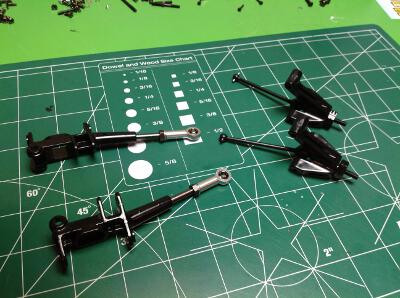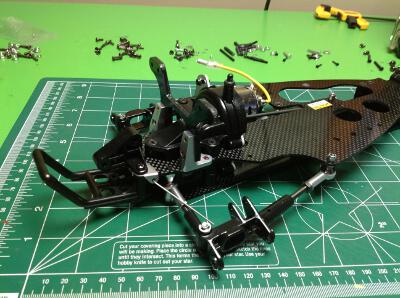Tamiya Avante Project
Page 2: Building the Suspension
Time to get started on the rather unusual suspension. The links
you see on the left are radius arms which are intended primarily to
carry thrust loads (power and braking). The vertical hubs are on
the right and include the wheel bearings. Note that the nice CVD
style axles are new for the 2011 re-release; the original used dog
bones. First the radius arms
are connected to the rear links we installed earlier and to the mid
chassis plate.
After that the vertical hubs are pinned in place, the
axles are installed. Installation of the upper rod completes the rear
suspension
geometry. Altering the length of the upper rod will change the
camber while altering the length of the radius arm will change the
toe. The sway bars have been attached to clips on the upper arms.
Here the front bumper has been attached along with the sway bar and
pivots. You can also see the little silver attachments for the
radius arms which pivot in a clear plastic tube. This plastic tube serves as a load relief for front tire impacts.
Very unusual front horizontal c-hubs here. These act as lower
control arms and the wide stance allows excellent thrust rigidity.
Time for the first cool gold anodized parts. The original cast
aluminum uprights were among the most fragile parts of the model and
were a real durability problem. The new gold uprights are machined
and are greatly strengthened. Here we them as part of the
highly complex front steering assembly. In the previous step we
saw the horizontal c-hub. The gold upright pins into it and
controls the camber pivot. Yet a third part, this time a plastic
knuckle,
pins into that one and controls the steering (and toe) pivot.
Front CV drives are also installed at this point in contrast to
universal axles on the original.
I'm not sure what the
logic was behind what to make gold and what to make silver. All
the rod ends are silver and and so are all the plate components.
If all the machined parts were gold, that would make sense but the rear
shock tower supports are silver. Somehow it all works and the model ends up looking coherent.
Now the upper arms are connected to the hubs completing the front
suspension. Continuing with the trend of being non-traditional
comes the steering. A lateral link connects the steering tie
rods. That link floats on a 4-bar linkage which pivots at two
points on the chassis plate. An L-shaped crank completes a right
angle turn allowing the servo attachment to drive longitudinally.
It all works fine, but there are a lot of joints and therefore many
places for friction or looseness.
The assembly method of the shocks is pretty standard. There's a
volume compensation bladder in the head end and the piston is retained
with E-clips. The unusual part is the tapered diameter of the
cylinder and matching tapered springs. The kit comes with Tamiya
"medium" 600 weight damper oil which seems about right.
At first glance these shocks appear the same as those used on the 1988
original, but there is an important difference. In the original,
the rod end seals were swaged into the cylinder and could not be
accessed or removed. In the 2011 version, the guide ring and seals
are installed with a plastic threaded retainer. The assembly
details can be seen in the exploded view above.
The rear shocks are installed in a pretty standard fashion, but the
front shocks face almost totally inboard. This is very good from
the point of view of having small frontal area and is also very strong
compared to a tall cantilever. This design avoids the tall front
shock tower that dominates the look of many buggies and makes the Avante
look different. The rear shock tower has been strengthened from
the original with a lateral gusset.
Update: I discovered much later that I had the rear arms
installed upside down. You can see how the shocks attach above the
wheel axis but they should be below. The result is that the rear
end sits much lower when built correctly.
This model is so special that I couldn't just use any old generic
servo. I was searching for something with an aluminum case,
ideally gold anodized to match. I couldn't find anything that
matched, but the Protek 160SS looks really nice and has impressive specs
(127 oz-in at 0.05s). After installing it, I also found it to be
the quietest servo I have ever used. It is nearly silent.
Sadly, once installed it is totally hidden. I actually wish you
could see it because it looks so cool.
The last step of chassis assembly is installation of the radio
gear. I've got a 2 channel Spektrum receiver and a Tamiya TLBE-02s
ESC. The battery is installed between the two chassis plates next
to the steering servo.
The final touch is the unique cam-loc wheel system. The wheels
have a traditional drive hex on the back, but instead of a wheel nut the
entire wheel cover is the nut. A pair of links fold out from the
cover to be used as levers to tighten the wheel, then you simply fold
them into the grooves in the wheel to lock. No tools
required. Works really well. I also took the opportunity to
use a paint pen to make the tire sidewall lettering white which I think
adds a lot of extra character. Unlike many Tamiya cars, this one
actually come with tire foams.
In addition to the clear body and wing, the model comes with a bottom
tray. This does a good job of protecting the carbon chassis
plates. It swivels down for battery access, but sadly you cannot
reach the connector without also removing the upper body. The
upper body is hard to remove because the lateral links which connect the
shock tower balls are in the way. You need to remove them every
time you remove the body.
I painted the model per the box instructions with Metallic Blue.
The wing is a little difficult to paint because of the very thin vertical
sections. Would be easier with an airbrush that you could get in
closer.
©2017 Eric Albrecht

